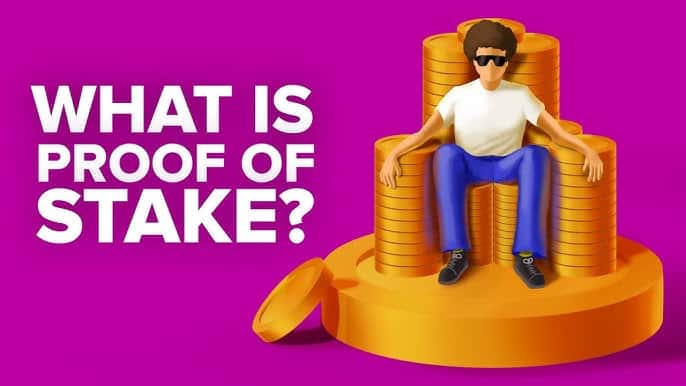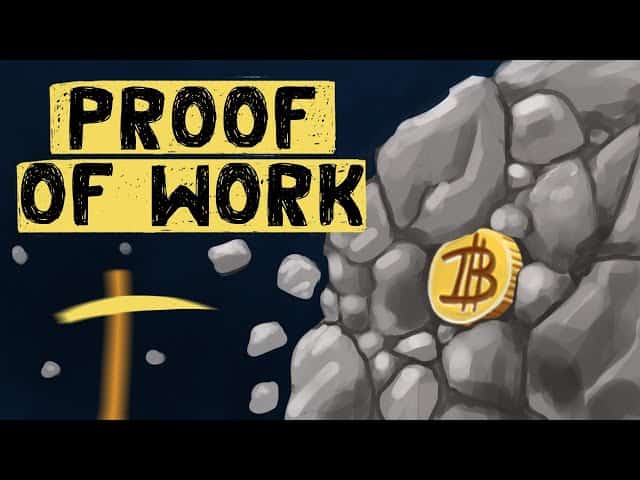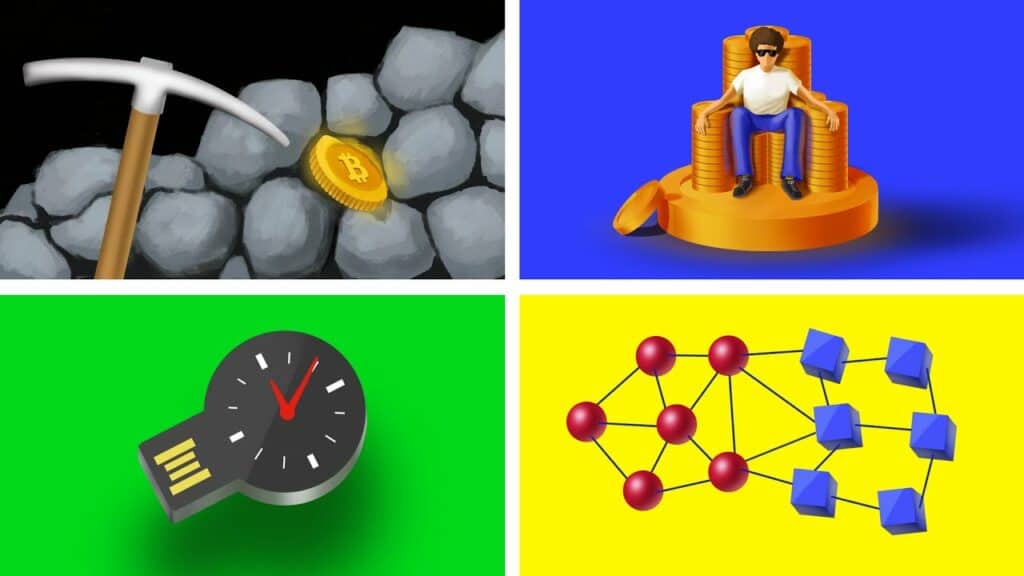We actually previously created a video on “What is Staking” where we described the Proof-of-Stake (PoS) mechanism, risks involved, and the benefits, but since it was our second video we made a big mistake. Yes, as all the commenters have noticed, audio is only working on the left ear.
As a way to apologize, we have decided to cover a very similar topic of staking where we discuss some other parts we skipped over in that video. This article will give satisfaction to both of your ears. We hope you can forgive us!
What is Proof of Stake?

Proof Of Stake (PoS) is a blockchain verification method that is much more energy-efficient and less risky than the more common Proof of Work (PoW) method. Only one miner is chosen at a time to validate the blockchain, but the miner must lock up some of their coins as collateral to be chosen.
Let’s dig in.
Proof of Work
First off, to understand Proof of Stake, you really need to understand Proof of Work (PoW).
Imagine there is a race and a bunch of people line up to the starting line. There are 6 foot people, there are 4 foot people, guys, girls, some people have injuries, others just drank a red bull, some are old, some young—you have a little bit of everyone at this race line. Boom goes the gun and everyone starts running.
Whoever wins the race gets the reward. There are no second or third place trophies, no participation trophies either. This is kinda how PoW actually works, except instead of one race, there are continually races back to back.
You don’t have to be a genius to figure out that whoever wins one race will likely win a bunch of others simply because they may be in the best shape with the best conditioning.
However, with PoW, there’s some luck involved. So even the small players, the dude who is on crutches that’s 75 years old has a chance to win, even if it’s a long ways away, he’s got a chance. Maybe everyone gets ahead of him, then lightning strikes and everyone else has to go to the hospital and that 75 year old on crutches wins.
Instead of runners, miners use computers to do the work. It is called “proof of work” because they are working hard to prove that some computation is true. In short, the better computers and the more you have, the more likely you will win.
Proof of Stake Example
Let’s move on to Proof of Stake (PoS). We still have all the runners, and they line up to the race. However, this time they don’t all run. Instead, we pick one runner to run and if they reach the finish line, they get the reward.
There’s a catch though! To be at the starting line to get picked, they have to put up a stake. A stake is money you lock up so that if you do something bad, your stake can be taken away. Why? This way you don’t do bad things.
Now, we know you have some questions, so let’s dive in.
What if they don’t finish the race?
There’s the big important question of what if we pick someone to run, but they never finish the race? Meaning what if we select them to validate a block, but they just give up?
Well, since they signed up to be a validator, and didn’t validate, either because they didn’t want to, the node was set up incorrectly, an internet connection issue, or because their computer turned off—we “slash” them.
Slashing is the term used when you take away some of their stake—some of those coins they initially locked up. If you don’t want to lose them, you better be a reliable node!
How do they get picked?
Every PoS model seems to have a few different factors that they combine to pick each validator to validate the block.
Some models take into consideration how many total coins they have staked—in theory the more you stake, the more trustable you should be.
Others take into consideration how long you have been staking—people who have staked for a long time ought to be reliable and trustable too.
Furthermore, some take randomness into consideration so that there is a fair way to get picked. Most models combine all of these, and if you want to know specifics, you’ll have to read the specific blockchain’s whitepaper.
How short is the race?
In PoW, we make the race longer the more people that run. In other words, we make the work harder and harder as more people join the network. This way blocks aren’t solved too fast, and aren’t too slow.
In terms of PoS, the “race,” or the validation computation, is shorted so much that a single computer can solve it quickly. In some cases, even a modern smartphone could solve the problem.
Take this in comparison to millions of expensive bitcoin miners out there mining for ten minutes to solve a single block.
What if someone cheats?
If someone cheats, or if they perform any type of fraud—like give themselves free coins or make a fake transaction—they are fact-checked and then their stake is removed.
This is the purpose of the stake in the first place—to make sure people aren’t joining and just sending themselves free crypto. Instead, we make it so anyone can fact-check a validator’s block and if they find an issue, there’s a way to report it and that validator will lose some, if not all, of their stake.
Proof of Work to Proof of Stake Transition

Proof of Work is a very successful consensus mechanism simply because in theory anyone can join, even if they have a small, less powerful computer.
As the network grows, then the cost to mine becomes even more, however those small, less powerful computers can still join the network, they are just playing a luck game.
They could still win, but it’s unlikely. But if you have an old laptop laying around, might as well, right? That’s the idea.
It is a good idea to move from PoW to PoS when a network grows very large. You don’t want to do it too early, because then the coin holders who stake their coins might be able to join together and perform a 51% attack.
You don’t want to do it too late, because there may be lots of people wasting massive amounts of electricity and the use of those computers. So Ethereum is switching right at the sweet spot—there are enough people interested that there are no sizeable whales which means the risk of a 51% attack is much lower.
If Ethereum started off as PoS, it may not have become so successful. In fact, this channel was started because I got interested in Ethereum mining—I could use my computers to earn useful money. This led me down a rabbit hole to learn how it all worked, and now my friend Neiko and I are sharing it with you.
Economics of Consensus Mechanisms

Let’s talk about the economics of Proof of Work and Proof of Stake.
In Proof of Work, you are investing in computer hardware and electricity. This incentivizes people to find a way to get cheaper electricity; we hope that it’s cleaner too, but there’s no reason miners should use clean energy unless it’s more affordable.
In terms of computer hardware, we saw what profitable Ethereum mining did to graphic cards—prices of GPUs a few years old were higher than their original MSRP because they could earn such a high return.
This incentivizes the growth of faster computing and the increase of production for equipment manufacturers.
In Proof of Stake though, what is incentivized? Well, to become a miner, you have to buy the coin. So instead of investing in the hardware or electricity, you are actually investing in the native coin itself, which by supply and demand, would put a lot of demand on the coin since it can produce an income.
This means switching to PoS should increase the price of a coin, by inherently increasing the value of the coin.
Will Bitcoin Change to Proof of Stake?
In short, no. The code of Bitcoin is not coded to switch it’s consensus mechanism from Proof of Work to Proof of Stake. The creator, Satashi Nakamoto, is unknown and remains unknown so the code will stay unchanged.
The only way Bitcoin could switch to PoS is through a fork. If you don’t know what a fork is, you can check out our page about it for more info.
What would it take to change to PoS?
So Bitcoin is only changed if there is a fork. A fork is basically a change in code, and for that code to be accepted, we would need 51% of everyone on the network to agree to the change. If 51% of everyone on the network agreed, the code that is running Bitcoin could change to Proof of Stake.
But that is highly unlikely because a large majority of the Bitcoin community wants to keep the code original and pure—they want to keep the code the same as it was written, as much as possible, other than fixing major bugs.
Delegated Proof of Stake
This article is about proof of stake, but that means we should explain a small variation called “delegated proof of stake”.
Instead of setting up a validator node yourself, hoping your computer stays online and your internet connection is reliable, you can stake your coins and then use your voting power to delegate to someone else.
This way you can vote without needing special equipment or knowledge. Delegated proof of stake has it’s benefits and drawbacks, which you can learn more about on our page about consensus mechanisms.
Conclusion
There’s a lot of benefit in Proof of Stake, including better use of energy and more accessible contributions to the network. But there are concerns about security and centralization, if some people are able to buy a ton of the crypto needed to stake.
Thanks for reading, we hope you enjoyed it, and we really hope you learned something!

